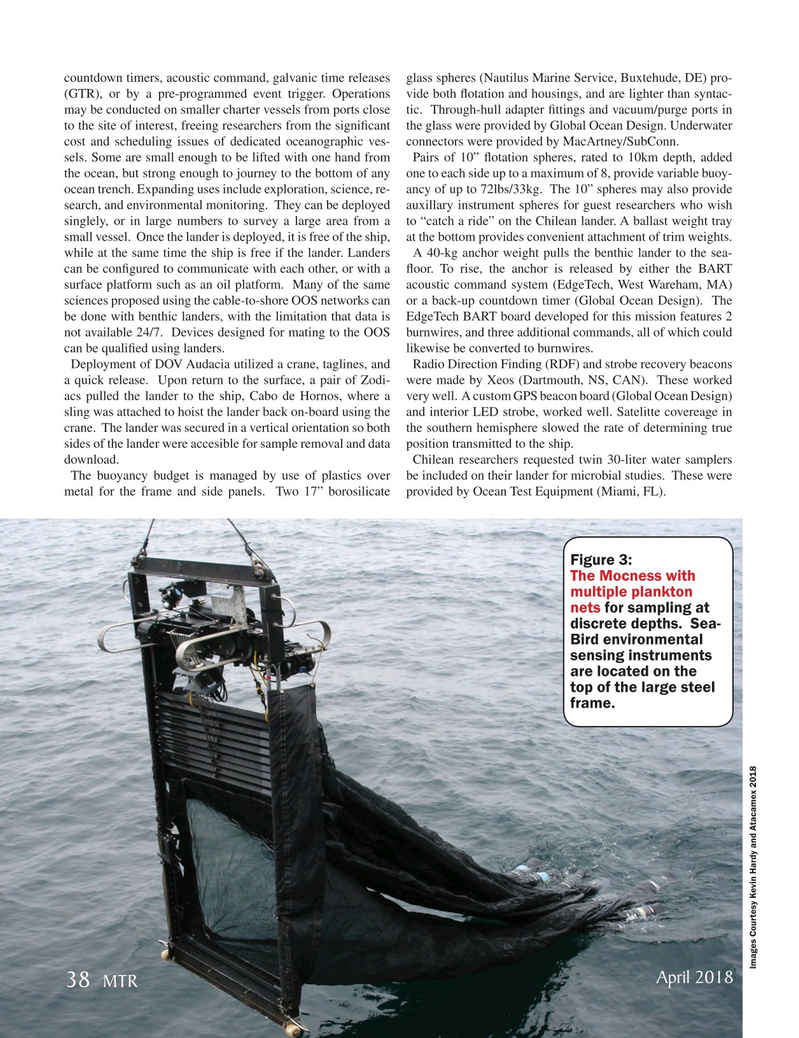
Page 38: of Marine Technology Magazine (April 2018)
Offshore Geophysical
Read this page in Pdf, Flash or Html5 edition of April 2018 Marine Technology Magazine
countdown timers, acoustic command, galvanic time releases glass spheres (Nautilus Marine Service, Buxtehude, DE) pro- (GTR), or by a pre-programmed event trigger. Operations vide both ? otation and housings, and are lighter than syntac- may be conducted on smaller charter vessels from ports close tic. Through-hull adapter ? ttings and vacuum/purge ports in to the site of interest, freeing researchers from the signi? cant the glass were provided by Global Ocean Design. Underwater cost and scheduling issues of dedicated oceanographic ves- connectors were provided by MacArtney/SubConn. sels. Some are small enough to be lifted with one hand from Pairs of 10” ? otation spheres, rated to 10km depth, added the ocean, but strong enough to journey to the bottom of any one to each side up to a maximum of 8, provide variable buoy- ocean trench. Expanding uses include exploration, science, re- ancy of up to 72lbs/33kg. The 10” spheres may also provide search, and environmental monitoring. They can be deployed auxillary instrument spheres for guest researchers who wish singlely, or in large numbers to survey a large area from a to “catch a ride” on the Chilean lander. A ballast weight tray small vessel. Once the lander is deployed, it is free of the ship, at the bottom provides convenient attachment of trim weights.
while at the same time the ship is free if the lander. Landers A 40-kg anchor weight pulls the benthic lander to the sea- can be con? gured to communicate with each other, or with a ? oor. To rise, the anchor is released by either the BART surface platform such as an oil platform. Many of the same acoustic command system (EdgeTech, West Wareham, MA) sciences proposed using the cable-to-shore OOS networks can or a back-up countdown timer (Global Ocean Design). The be done with benthic landers, with the limitation that data is EdgeTech BART board developed for this mission features 2 not available 24/7. Devices designed for mating to the OOS burnwires, and three additional commands, all of which could can be quali? ed using landers. likewise be converted to burnwires.
Deployment of DOV Audacia utilized a crane, taglines, and Radio Direction Finding (RDF) and strobe recovery beacons a quick release. Upon return to the surface, a pair of Zodi- were made by Xeos (Dartmouth, NS, CAN). These worked acs pulled the lander to the ship, Cabo de Hornos, where a very well. A custom GPS beacon board (Global Ocean Design) sling was attached to hoist the lander back on-board using the and interior LED strobe, worked well. Satelitte covereage in crane. The lander was secured in a vertical orientation so both the southern hemisphere slowed the rate of determining true sides of the lander were accesible for sample removal and data position transmitted to the ship.
download. Chilean researchers requested twin 30-liter water samplers
The buoyancy budget is managed by use of plastics over be included on their lander for microbial studies. These were metal for the frame and side panels. Two 17” borosilicate provided by Ocean Test Equipment (Miami, FL).
Figure 3:
The Mocness with multiple plankton nets for sampling at discrete depths. Sea-
Bird environmental sensing instruments are located on the top of the large steel frame.
Images Courtesy Kevin Hardy and Atacamex 2018
April 2018 38
MTR
MTR #3 (34-48).indd 38 MTR #3 (34-48).indd 38 4/6/2018 8:35:41 PM4/6/2018 8:35:41 PM

 37
37

 39
39
